Physical Address
304 North Cardinal St.
Dorchester Center, MA 02124
The skin is, contrary to the ubiquitous simplistic concept, a remarkably heterogeneous organ. The nodular lesions (hamartomatous, reactive, and neoplastic) that occur in the skin are more numerous than those produced by any other organ. For example, the eccrine sweat gland alone gives rise to 10 or more histologically distinct adenomas. This diversity, combined with a body of descriptive data (clinical, histologic, histochemical, immunohistochemical, and ultrastructural) amassed over the past century and dispersed in varying literatures, produces confusion, chiefly in the area of nomenclature. Within the limits inherent in a textbook that covers a breadth of surgical pathology specialties, it is impossible to pursue finite segmentation, interesting and accurate as it may be. The more common lesions will be discussed in some detail and pertinent references provided for the rare lesions.
Most of the mesenchymal tumors that may involve the dermis are discussed in the chapter on soft tissues. Only those showing exclusive or preferential involvement of the skin are included in this chapter.
Seborrheic keratoses are common, benign, pigmented, predominantly basal keratinocytic proliferations occurring chiefly on the trunk of adults. They may be single or multiple. The sudden appearance of, or increase in the number and size of, seborrheic keratoses in association with internal malignant disease is known as the Leser–Trélat sign .
Grossly, the lesions of seborrheic keratosis protrude above the surface of the skin, are soft, and vary in color from tan to black. The single, heavily pigmented seborrheic keratoses may be confused clinically with malignant melanoma.
Microscopically, the number of epidermal basal cells is greatly increased, presumably as a result of a maturation defect. The acanthotic pattern is the most frequent, in which a thick layer of basal cells is seen interspersed with pseudohorn cysts ( Fig. 3.1 ). Some of these cells contain melanin, as the result of transfer from neighboring melanocytes. Other microscopic variants of seborrheic keratosis are the hyperkeratotic , adenoid , acantholytic , and desmoplastic . The latter may simulate invasive squamous cell carcinoma. Psoriasiform keratosis is a recently described condition combining features of seborrheic keratosis and psoriasis, the true nature of which still needs to be determined.
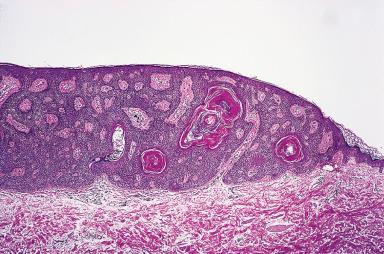
Immunohistochemically, the keratinocytes of seborrheic keratosis invariably express low-molecular-weight keratin but often exhibit a deficiency of the high-molecular-weight keratins.
In irritated seborrheic keratosis , squamous metaplasia is pronounced, often in the form of so-called squamous eddies. This phenomenon, presumably arising from the acrotrichia, should not be overdiagnosed as basosquamous carcinoma. It does not seem to be related to human papilloma virus (HPV). Instead, HPV can be identified in the seborrheic keratosis-like lesions of patients with epidermodysplasia verruciformis and in those exhibiting bowenoid changes. The latter should probably be interpreted as condylomas rather than as true seborrheic keratoses.
Malignant skin neoplasms of various types (particularly basal cell carcinoma) may be seen contiguous or adjacent to lesions of seborrheic keratosis. Seborrheic keratoses are genetically stable but frequently have mutations in a variety of oncogenes in the FGFR3-RAS-mitogen-activated protein kinase (MAPK) pathway but not tumor suppressor genes.
Benign lichenoid keratosis (lichenoid keratosis, lichen planus–like keratosis) presents as a solitary lesion, most commonly on the trunk or extremities of middle-aged and older patients. Clinically, they are often confused with basal cell carcinomas. Microscopically, the epidermis is acanthotic with hyperkeratosis and a thickened granular layer in association with a dense lichenoid lymphocytic infiltrate with interface change reminiscent of lichen planus.
Acrochordon is the preferred name for a common and inconsequential skin lesion also known as fibroepithelial papilloma, fibroepithelial polyp, fibroma molle, and skin tag. As these various names indicate, it is a polypoid lesion composed of varying amounts of stroma covered by a papillomatous epidermis. A clue to the diagnosis is the absence of adnexal structures in the underlying dermis.
A distinctive variant of this exophytic fibroepithelial process is represented by the acquired (digital) fibrokeratoma , characterized by collagenous protrusions covered by hyperkeratotic epidermis, usually occurring around interphalangeal joints but sometimes in other sites.
In that portion of the epidermis exposed to sunlight, chiefly that of the near ultraviolet (UV) spectrum, a sequence of atrophic, hyperplastic, and eventually dysplastic changes known as actinic keratosis may develop. The term “senile” keratosis, often used as a synonym, is inappropriate. An increased incidence of these changes has been found in renal transplant recipients, particularly in the lip region. Histologically, actinic keratoses involve the interfollicular epidermis, sparing the follicular apparatus and the intraepidermal portion of the sweat duct, as demonstrated in the classic article by Pinkus. The stratum corneum is replaced by a parakeratotic scale. Excessive production and accumulation of this scale lead to the formation of cutaneous horns. The granular layer is generally absent except at and about the follicular orifices. The malpighian layer shows disorderly maturation, as well as individually dysplastic and dyskeratotic cells ( Fig. 3.2 ). Morphologic variations on the theme of actinic keratosis include basaloid proliferations resembling early basal cell carcinomas, changes along the dermoepidermal junction resembling lichen planus (lichenoid actinic keratosis), suprabasal acantholysis producing vesicles similar to those of pemphigus vulgaris, a marked degree of keratinocytic atypia throughout the malpighian layer (bowenoid actinic keratosis), and the presence of large atypical clear cells (pagetoid actinic keratosis). Not infrequently, the basal melanocytes participate in the proliferation and atypia, resulting in a combination of actinic keratosis and actinic melanosis. Such cases appear clinically as heavily pigmented lesions.
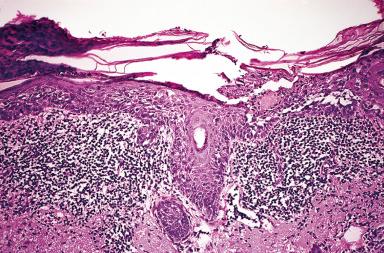
The papillary dermis is often chronically inflamed, and basophilic degenerative changes are prominent in the elastic fibers (solar elastosis). In florid forms of actinic keratosis, the atypical epithelial proliferation produces irregularly elongated acanthotic ridges, and this process extends down the external root sheaths of the hair follicles. In such cases, the differential diagnosis with superficially invasive squamous carcinoma inevitably arises.
Accumulation of p53 protein, presumably as a result of mutation, has been found in almost three-fourths of actinic keratosis lesions and found to correlate with the degree of atypia. Genetically, mutation of TP53 is found in 50% of cases, being less frequent than in cutaneous squamous cell carcinoma. The mutations in TP53 are predominantly C to T transitions, in keeping with ultraviolet radiation damage. In addition, loss of heterozygosity at multiple chromosome sites is common. Progression to squamous cell carcinoma may be mediated by inactivation of INK4A (p16).
Actinic keratoses may be treated by a variety of methods—freezing, superficial curettage, application of antineoplastic chemotherapeutic agents, and surgical excision. Excision is unnecessarily radical therapy except for the more florid and infiltrative types and those not responding to topical 5-fluorouracil.
Cutaneous horn (cornu cutaneum) is the traditional picturesque term for a protruding skin lesion largely composed of keratin and resembling a horn in shape. The lesion can reach a gigantic size and truly resemble an animal horn. Because the clinical appearance of cutaneous horn can result from a variety of diseases, cutaneous horn should not be used as a pathologic term. Most cases are caused by actinic keratosis, but others may be the result of verruca, seborrheic keratosis, inverted follicular keratosis, or squamous cell carcinoma. The keratin formed is usually of epidermal type, but occasionally it has trichilemma-like features (i.e., it contains deep red granules). When this is the case, the lesion has been referred to as trichilemmal keratosis, verrucous trichilemmal tumor, and trichilemmal horn.
Bowen disease is a form of squamous cell carcinoma in situ that consists clinically of indolent, scaly, erythematous plaques occurring predominantly on non-chronically sun-exposed skin ( Fig. 3.3 ). Histologically, the lesions show a variety of atypical epithelial changes, such as cytoplasmic vacuolization, nuclear hyperchromasia, multinucleated keratinocytes, individual cell dyskeratosis, and increased number of mitoses, including atypical forms ( Fig. 3.4 ). The maturation pattern is markedly altered (as made very apparent with the Mib-1 stain), but some surface flattening and keratinization are almost always present. Extension of the process into the eccrine sweat glands may occur. In its fully developed stage, Bowen disease can be regarded as a carcinoma in situ of the skin or as a form of squamous intraepidermal neoplasia, a concept supported by the presence of mutant p53 protein, and of distinct aneuploidy in flow cytometric studies. It should be emphasized that the diagnosis of Bowen disease is a clinicopathologic one. Lesions showing similar microscopic changes but located in sun-exposed areas and having the clinical appearance of actinic keratosis should not be diagnosed as Bowen disease but rather as bowenoid actinic keratosis . An important difference between the two conditions is that in actinic keratosis there are atypical squamous cells in the lower portions of the epidermis including the basal layer, whereas in Bowen disease there are atypical squamous cells in all portions of the epidermis but with preservation of the basal cells, which are arranged in palisades. Differences can also be appreciated at the immunohistochemical level.
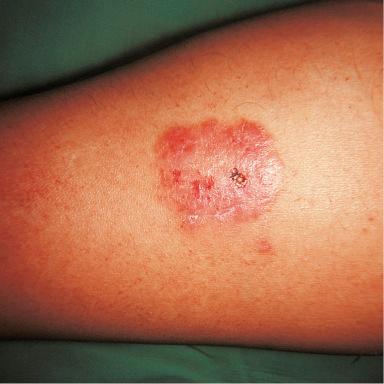
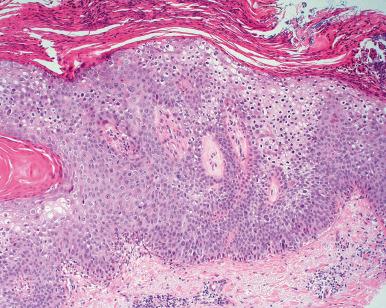
Occasionally, lesions of Bowen disease have a papillated appearance, others show a verrucous–hyperkeratotic pattern, and still others contain large atypical clear cells simulating Paget disease (pagetoid Bowen disease) ; even more rarely, the latter two processes coexist.
Some studies have shown an apparent increase in the incidence of visceral cancer in patients with Bowen disease, but others have failed to document such an association. Because arsenic is capable of inducing hyperplastic and dysplastic epidermal changes that may lead to the development of invasive squamous cell carcinoma, this element has been looked for in lesions of Bowen disease, but the search has proved inconclusive.
The large majority of squamous cell (epidermoid) carcinomas of the skin are actinically induced, one of the postulated pathogenetic mechanisms being the induction of TP53 mutations by ultraviolet light ( Fig. 3.5 ). The incidence of this tumor is directly related to the amount of exposure to the sun and the lack of pigmentation of the skin. Blond, blue-eyed, fair-skinned people living in Texas have a higher incidence of skin cancer than do their counterparts in Minnesota. Squamous cell carcinoma in black people is a very rare disease. In urban populations, frankly invasive squamous cell carcinoma is uncommon, whereas in rural populations it is common. Nearly all of these actinic-induced tumors are preceded and accompanied by lesions of actinic keratosis.
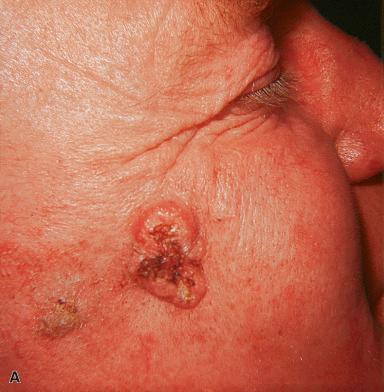
Squamous cell carcinomas of the skin can also be seen as a complication of the following:
Xeroderma pigmentosum, a genetically determined condition characterized by a diminished capacity for DNA repair following ultraviolet light irradiation. These patients may also develop basal cell carcinomas and malignant melanomas.
Epidermodysplasia verruciformis, a generalized virally induced dermatosis.
Cutaneous scars of various types: from burns (Marjolin ulcer), x-rays, epidermolysis bullosa, chronic osteomyelitic sinuses, necrobiosis lipoidica, acne aggregata seu conglobata, or hidradenitis suppurativa.
Chemical exposure: arsenic, coal tars, soot, and a variety of oils and distillation products.
Immunocompromise. In organ transplant recipients the carcinomas are often associated with severe actinic keratosis or, less commonly, widespread warts. HPV has been detected in these lesions. The clinical course can be very aggressive. In the human immunodeficiency virus (HIV)-infected population there is an increased risk for both squamous cell and basal cell carcinoma. The tumors tend to be larger, less differentiated, and more deeply invasive.
PUVA-treated psoriatic patients, in whom the risk is dose dependent.
Ichthyosis, epidermal nevus, porokeratosis, and congenital lymphedema. Only a few cases have been reported in each of these disorders.
Smoller et al. have shown that an “activated” keratinocyte phenotype—characterized by a particular staining pattern for ψ-3, involucrin, filaggrin, and keratins—is the common denominator for the conditions that predispose to squamous cell carcinoma.
More than 80% of squamous cell carcinomas are well differentiated and, as such, produce large amounts of keratin ( Fig. 3.6 ). Some of this is seen in the form of horn pearls, particularly in the better differentiated tumors; characteristically, keratohyaline granules within these pearls are sparse or absent. So-called intercellular bridges can be found with ease in most cases. The pattern of growth may be polypoid or even papillary or may have a deep penetrating quality. Sometimes the tumors are cup-shaped in the manner of keratoacanthomas.
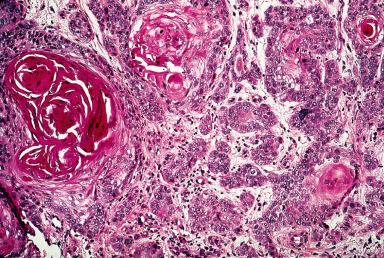
Invasion of the dermis is sine qua non for the diagnosis, but this may be a very subjective evaluation in the early stages. A lesion interpreted by some as florid actinic keratosis may be interpreted by others as a superficially invasive squamous cell carcinoma. This is a reflection of the fact that actinic keratosis and squamous cell carcinoma are part of a continuous spectrum of squamous neoplasia. Fortunately, the issue is of no great practical importance, because the treatment and prognosis for these borderline lesions are essentially the same.
Squamous cell carcinoma may contain a population of non-neoplastic dendritic melanocytes, with transfer of some of the melanin granules into the cytoplasm of the tumor cells (pigmented squamous cell carcinoma); this phenomenon is analogous to that seen more commonly in basal cell carcinoma.
Occasionally, the tumor has a clear cell appearance throughout, raising the differential diagnosis with a variety of adnexal tumors, as well as suggesting the possibility that the change may reflect an abortive attempt at trichilemmal differentiation in the squamous cell carcinoma. Even more rarely, the tumor may have a component of signet ring cells.
Squamous cell carcinomas of the skin exhibit immunoreactivity for high-molecular-weight keratins, involucrin (a precursor of the cross-linked envelope protein of the stratum corneum), epithelial membrane antigen (EMA), and often also carcinoembryonic antigen (CEA) and p63. Poorly differentiated tumors can also be immunoreactive for vimentin. In contrast to basal cell carcinomas, squamous cell carcinomas tend to be negative for Ber-EP4 and CD10. Basement membrane components, such as laminin and type IV collagen, can be found surrounding some of the tumor nests.
Accumulation of p53 protein has been detected in close to half of cases.
Up to 90% of cutaneous squamous cell carcinomas harbor the TP53 mutation, with frequent C→T or CC→TT transitions as signatures of ultraviolet radiation–induced mutagenesis. The frequent presence of the TP53 mutation in the precursor lesion actinic keratosis, as well as normal-looking epidermal cells adjacent to squamous cell carcinoma, suggests that this genetic alteration is an early event in carcinogenesis. Inactivation of the RB/P16 pathway through mutation or promoter hypermethylation of INK4A also appears to play a role. Recent studies also implicate activation of the NF-κB pathway to contribute to the malignant phenotype of cutaneous squamous cell carcinoma. Activating mutations in HRAS and KRAS are found in 46% and 4%–12% of cases, respectively. Promoter hypermethylation of the E-cadherin gene CDH1 is reported in 95% of cases.
Spindle squamous cell carcinoma (metaplastic sarcomatoid squamous cell carcinoma) usually occurs in sun-exposed areas and is relatively common in the lip ( Fig. 3.7 ). The differential diagnosis includes malignant melanoma and atypical fibroxanthoma. Continuity of tumor cells with the basal layer of the epidermis, foci of clear-cut squamous change, and high-molecular-weight keratin immunoreactivity are the most important distinguishing features. Vimentin is consistently coexpressed by these tumors. Carcinosarcoma is the term used when there is a sharp segregation between the epithelial and the sarcoma-like components. When the distinction between spindle cell carcinoma and a mesenchymal tumor is not possible (a not uncommon occurrence), the noncommittal term sarcoma-like tumor of the skin may be used.
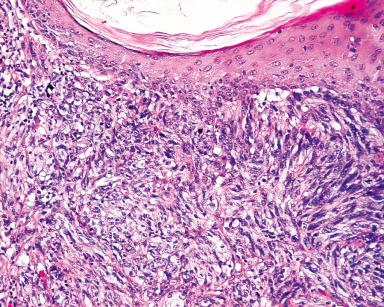
Adenoid (pseudoglandular; acantholytic) squamous cell carcinoma results from acantholysis (i.e., lack of cell cohesiveness caused by a desmosomal defect) ( Fig. 3.8 ). Sometimes the pattern simulates an angiosarcoma (pseudoangiosarcomatous carcinoma). Nearly all cases occur in sun-exposed areas, and many are associated with actinic keratosis with acantholysis. Immunohistochemically, there is a preferential reduction of the cell adhesion molecule syndecan-1. The differential diagnosis includes primary and metastatic adenocarcinoma, true adenosquamous carcinoma of the skin (a rare aggressive neoplasm that exhibits squamous differentiation and mucin production), and mucoepidermoid carcinoma (an even rarer tumor of probable sweat gland derivation).
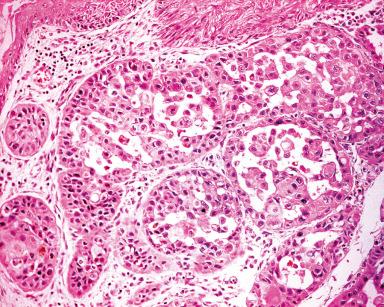
Verrucous carcinoma is an extremely well-differentiated type of squamous cell carcinoma, also known in the skin as carcinoma or epithelioma cuniculatum . It appears as an ulcerated, fungating, and polypoid mass with openings of sinus tracts onto the skin surface. Most cases are located in the sole of the foot ( Fig. 3.9 ). Local invasion is the rule, and extension to bone is frequent, but nodal metastases are exceptional. It is regarded as the cutaneous counterpart of the more common verrucous carcinoma of the oral cavity and other mucosal membranes, and, like them, it may be positive for HPV.
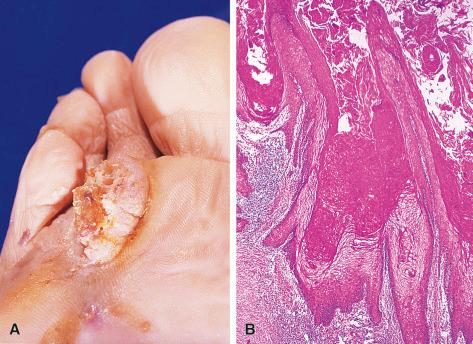
Complete excision remains the treatment of choice for most squamous cell carcinomas. Careful pathologic examination, including inked surgical margins, allows identification of those cases in which the tumor has been transected. Depending on the size and location of the tumor and the general condition of the patient, alternative therapies include curettage and electrodessication, cryotherapy, and radiation therapy.
The overall prognosis of squamous cell carcinoma is excellent, particularly for the actinic-induced tumors. Superficially invasive cancers (less than 1.5 cm) metastasize only occasionally. Even in lesions larger than 2 cm with unequivocal invasion into the reticular dermis, the incidence of regional lymph node metastases is less than 5%. The best prognostic factors are staging, level of dermal invasion, and vertical tumor thickness. In one series, all tumors that recurred were 4 mm or more thick and involved the deep half of the dermis or deeper; all tumors that proved fatal were at least 1 cm in maximum thickness, and most extended into the subcutaneous fat or beyond. In another series, the prototypical metastatic squamous cell carcinoma had a width of at least 1.5 cm, a vertical tumor thickness of at least 2 mm, poor differentiation, desmoplasia, and a mixed inflammatory infiltrate. The presence or absence of actinic keratosis at the edge of a squamous cell carcinoma is not as useful a predictor of behavior as tumor thickness or level of invasion.
At sites of trauma, chronic irritation, and ulcers, the reparative hyperplasia of the epidermis may produce seemingly invasive tongues of epithelial cells. This abnormality, known as pseudoepitheliomatous (pseudocarcinomatous) hyperplasia , can also be caused by mycotic infections (particularly North American blastomycosis), bromoderma, pyoderma vegetans, tuberculosis, syphilis, granular cell tumor, and melanocytic lesions (particularly Spitz nevi but also malignant melanoma). The epithelial proliferation is generally associated with a dermal fibroblastic and vascular proliferation and a prominent acute or subacute inflammatory infiltrate. Characteristically, the proliferating strands of epithelium are thin, markedly elongated, anastomosing, and heavily infiltrated by inflammatory cells ( Fig. 3.10 ).
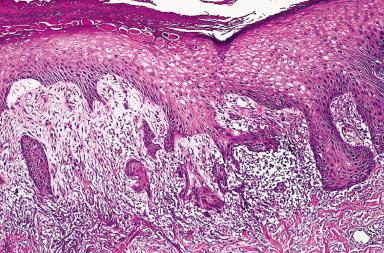
Clear separation of pseudoepitheliomatous hyperplasia from squamous cell carcinoma is not always easy. The width of the strands (thin in hyperplasia and broad in carcinomas) and the degree of keratinocytic atypia (greater in the carcinoma) are the main distinguishing features. It should be kept in mind that the presence of an intraepidermal inflammatory infiltrate, no matter how heavy, does not rule out the diagnosis of squamous cell carcinoma. We have seen several cases with clear-cut architectural and cytologic features of carcinoma that were repeatedly underdiagnosed as pseudoepitheliomatous hyperplasia because of their association with a prominent lymphocytic, neutrophilic, eosinophilic, or granulomatous infiltrate.
Basal cell carcinoma derives its name from the cytologic similarity of the tumor cells to the normal basal cells of the epidermis and the traditional belief that it arises from them. In our opinion, all basal cell carcinomas attempt to differentiate toward adnexal structures (particularly pilosebaceous units), but most of them remain at a stage so primitive as to render this recognition not immediately apparent. The belief that basal cell carcinomas represent primitive “adnexal” carcinomas has been voiced over the years by several authors and is supported by the marked immunohistochemical similarities that exist between basal cell carcinoma and tumors of indubitable hair follicle derivation, among them the common immunoreactivity for CD10. Some authorities who initially denied the concept have now gone as far as flatly stating that basal cell carcinoma is a trichoblastic carcinoma.
Basal cell carcinoma is the most frequent form of skin cancer; it occurs predominantly on sun-exposed skin in direct proportion to the number of pilosebaceous units present therein, a feature supporting the previously stated histogenetic interpretation. Fair-skinned, blue-eyed persons engaged in outdoor occupations suffer a higher incidence of these tumors. Synchronous and metachronous tumors are frequent. Exceptionally, children and young adults are affected.
Basal cell carcinomas may also develop in sunlight-protected skin, in nevus sebaceus of Jadassohn, in the lower leg in association with chronic venous stasis and other preexistent conditions, over arteriovenous malformations, and following arsenic ingestion, x-ray exposure, skin injury, chickenpox scars, tattoos, hair transplantation scars, and immune suppression.
The clinical appearance of basal cell carcinoma is as variable as its histologic patterns. Nodular , ulcerative , superficial , erythematous , sclerosing (morphea-like), and keloidal forms occur ( Fig. 3.11 ).
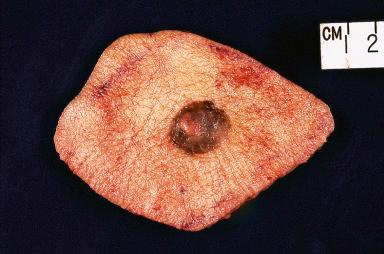
Basal cell nevus syndrome (Gorlin syndrome) is characterized by multiple basal cell carcinomas, palmar pits, calcification of dura, keratocysts of the jaws, skeletal anomalies, and occasional abnormalities of the central nervous system, mesentery, and endocrine organs ( Fig. 3.12 ). Microscopically, the basal cell carcinomas in this setting exhibit a broader spectrum of subtypes than the sporadic tumors. The syndrome should be suspected when basal cell carcinomas are seen in young people who have multiple tumors, many of which are of the superficial multicentric type and in which osteoid is an occasional finding. It is caused by a germline inactivating mutation in the PTCH1 gene located at chromosome 9q22.3–q31. Mutations in PTCH1 are also found in a significant number of sporadic basal cell carcinomas.
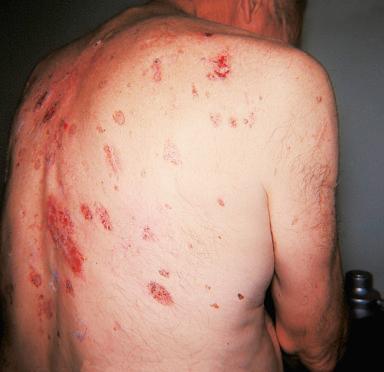
As stated in the preceding section, basal cell carcinomas arise from basally located cells of the epidermis and pilosebaceous units and differentiate incompletely in the direction of adnexal (primarily follicular) structures. Epidermal attachment is present in nearly all cases. The tumors may have solid, cystic, adenoid, keratotic, pigmented, infiltrating, and sclerosing (morphea-like) patterns ( Fig. 3.13 ). The keratotic pattern probably represents an expression of differentiation toward the infundibular portion of hair follicles, has no clinical significance, and should be distinguished from so-called basosquamous carcinoma.
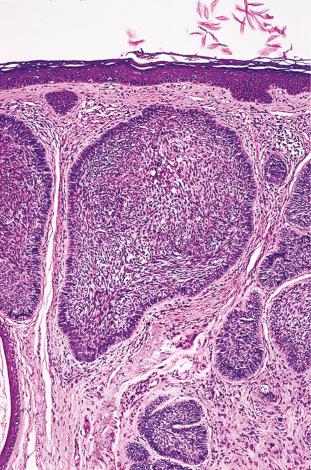
The nests of basal cell carcinoma show prominent palisading and are surrounded by a typical loose stroma, which contains myofibroblasts and often exhibits myxoid change. Cleft-like retraction spaces, some of artifactual nature and others resulting from the accumulation of stromal mucin, are often seen between the epithelial nests and the stroma. Melanin can accumulate in dermal macrophages between the tumor nests and result in a “pigmented” appearance clinically and histologically ( Fig. 3.14 ). Langerhans cells can also be present. Intercellular amyloid material is not infrequent, sometimes accompanied by the deposition of immunoglobulins. Oval to spindle tumor cells with hyaline eosinophilic cytoplasm have been found in a few cases and interpreted by some authors as evidence of myoepithelial differentiation (see also section “ Other Microscopic Types ” later). Mitotic activity (sometimes accompanied by atypical forms), marked atypia with the appearance of bizarre (“monster”) tumor cells, and giant cell formation may occur, but there is no convincing evidence that any of these features carries prognostic significance. In other instances the atypia is present in the reactive stromal cells and is equally inconsequential. The stroma may undergo osseous metaplasia, sometimes to a considerable degree ; in other instances, it may contain peculiar collagen crystal-like structures.
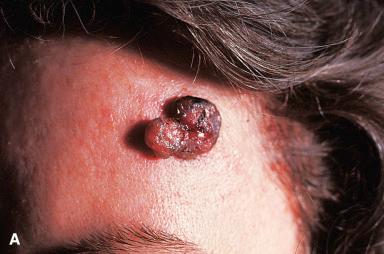
Rarely, matrical (shadow cell formation), eccrine, or sebaceous differentiation or markedly thickened basement membrane is seen in otherwise typical basal cell carcinoma, further supporting the close relationship of these tumors with adnexal structures. Perineurial or endoneurial invasion by tumor cells is rarely present and is more common in the infiltrating/morpheaform variants. Sometimes, a basal cell carcinoma is seen adjacent to a benign melanocytic nevus, the juxtaposition being a coincidental event.
The differential diagnosis of basal cell carcinoma includes the areas of highly organoid basaloid proliferation sometimes seen in the epidermis overlying dermatofibromas and the more atypical foci of basaloid proliferation that may be found in association with actinic keratosis and Bowen disease (see respective discussions).
Immunohistochemically, the cells of basal cell carcinoma are positive for keratin (particularly low-molecular-weight type) but usually negative for EMA, CEA, and involucrin. Other markers commonly expressed are CD10 (as mentioned previously), Ber-EP4, and androgen receptors. The basement membrane that surrounds the tumor nests reacts with antibodies against laminin, types IV and V collagen, and bullous pemphigoid antigen. The pattern of staining for these markers tends to be attenuated and discontinuous, as an expression of the disruption of this structure. This feature is more prominent in the aggressive tumors.
A suggestion was made some years ago that basal cell carcinomas may show neuroendocrine differentiation, with immunoreactivity for CD56, chromogranin, and synaptophysin ; although the relatively common finding of argyrophilia may seem to support this contention, immunoreactivity for neuroendocrine markers, such as chromogranin or neuron-specific enolase (NSE), is uncommon. Importantly, basal cell carcinoma is negative for cytokeratin 20, which allows distinction from Merkel cell carcinoma and trichoepitheliomas, which typically have scattered retained Merkel cells in the tumor islands. It has been shown that most basal cell carcinomas stain for Ber-EP4, whereas most squamous cell carcinomas do not. They also commonly express BCL2, a feature of alleged value in the differential diagnosis with actinic keratosis and squamous cell carcinoma.
More than 80% of basal cell carcinomas overexpress p53 protein, and this figure is even higher in the more aggressive types (see later). Clonal chromosome aberrations are frequent, most often represented by the numerical changes +18, +9, +20, +7, and +5. Dysregulation of the Hedgehog pathway is a key pathogenetic event in basal cell carcinoma. In the absence of Hedgehog ligands, protein patched homolog 1 (encoded by PTCH1 ) normally inhibits the transmembrane protein Smoothened (encoded by SMOH ), leading to a cascade that represses expression of the Hedgehog downstream target genes. In basal cell carcinomas, inactivating somatic mutation and allelic loss of PTCH1 , the gene implicated in the basal cell nevus syndrome, are common (67% and 53% of cases, respectively). In 10% of cases, activating mutations of SMOH are present instead. These genetic changes result in activation of the Hedgehog pathway. A recent study has successfully used GDC-0449, a small-molecule inhibitor of smoothened, for treatment of advanced basal cell carcinoma. Vismodegib and sonidegib, both inhibitors of the Hedgehog pathway, have activity against basal cell carcinoma with significant antitumor effect in large unresectable tumors and rare cases of metastatic basal cell carcinoma. Mutation in TP53 is found in approximately 30%–40% of cases. Presence of trisomy 6 has been correlated with the metastatic potential of the tumor.
Superficial basal cell carcinoma arises in skin with sparse, fine hairs and epidermis that is thin, such as that of the trunk. It grows chiefly in a lateral direction, beneath a relatively flat epidermis, and exhibits a high recurrence rate.
Basosquamous (metatypical) carcinoma has the general configuration of a basal cell carcinoma, but it also contains atypical squamous cells. This variant is more aggressive than conventional basal cell carcinoma. A high proportion of the metastasizing basal cell tumors belong to this type, which should be distinguished from the keratotic form of basal cell carcinoma.
Granular cell basal cell carcinoma contains tumor cells with cytoplasmic granules analogous in every way to those seen in granular cell tumor of the dermis and other locations. No clinical significance is ascribed to this variety.
Clear cell basal cell carcinoma contains tumor cells with prominent cytoplasmic vacuoles ; in other cases the tumor cells may even have a signet ring configuration, perhaps indicative of myoepithelial cell differentiation.
Infundibulocystic basal cell carcinoma is a variant of basal cell carcinoma in which evidence of hair follicle differentiation is much more evident and advanced than in the ordinary type; it could be viewed as being situated between the latter and trichoepithelioma in terms of the differentiation spectrum.
Fibroepithelioma of Pinkus (fibroepithelial tumor; Pinkus tumor) often occurs on the back ( Fig. 3.15 ). It has been traditionally regarded as a polypoid variant of basal cell carcinoma, and it has been suggested that the fibroadenoma-like pattern of this tumor is the result of eccrine duct spread. Other authors view it as a “fenestrated” variant of trichoblastoma. To us, this tumor provides yet another piece of evidence of the intimate relationship of basal cell carcinoma with the pilosebaceous unit.
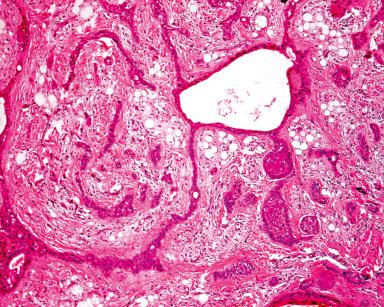
Sarcomatoid basal cell carcinoma is a relatively new variant, characterized by areas of conventional basal cell carcinoma intimately admixed with heterologous bone formation (termed osteosarcomatous differentiation by the authors). Its behavior does not seem particularly aggressive.
Basal cell carcinoma usually grows in a slow and indolent fashion. However, if untreated, the tumor may invade the subcutaneous fat, skeletal muscle, and bone (“ulcus rodens”) . Tumors of the face may invade skull, nares, orbit, or temporal bone via the auditory canal. They can thus reach the central nervous system and produce lethal meningitis. Microscopically, the locally more aggressive tumors tend to show loss of peripheral palisading and a dense, fibrous stroma rather than a loose myxoid stroma. At a statistical level, they also show decreased expression of syndecan-1 and BCL2, greater expression of p53, higher AgNOR count, and higher incidence of aneuploidy than the others.
In terms of location, local recurrence is more common in tumors of the nasolabial fold, inner canthus, and postauricular region. This is probably the combined result of the highly irregular infiltrative pattern that these tumors often exhibit, and the fact that in these locations the distance to the surgical margins tends to be rather close. In general, the microscopic appearance of the recurrence is not substantially different from that of the original tumor. Distant metastases are extraordinarily rare, but more than 100 cases have been reported. These include cases associated with the basal cell nevus syndrome. Approximately 60%–75% of these metastases involved the regional lymph nodes, and the others affect such organs as lung, bone, and liver. Metastases in basal cell carcinoma are more likely in the basosquamous types, in those with perineurial spread, and in tumors located on sunlight-protected skin.
Excision, curettage and desiccation, and irradiation used appropriately cure most basal cell carcinomas. Even when these tumors extend to the margin of surgical excision (an occurrence of approximately 5% in large series), only one-third will show evidence of recrudescence over the ensuing 2–5 years. Thus immediate reexcision is not always indicated under these circumstances. Actually, it has been suggested that evaluation of the pattern of tumor growth (widely dispersed vs. tightly clustered nests) is a better predictor of local recurrence than presence or absence of tumor at the surgical margins.
Recurrent basal cell carcinomas can be treated with radiation therapy or surgical reexcision. In some institutions, these recurrent tumors (and increasingly, many others, whether recurrent or not) are being treated by a procedure known as Mohs micrographic surgery. In this setting the Mohs surgeon reviews complete en face surgical margins by frozen section, to ensure complete evaluation of the margins intraoperatively. In the United States, this technique has been advocated for certain basal cell carcinoma subtypes and for basal cell carcinomas in cosmetically sensitive locations. While there is literature that supports the concept that this results in a decrease in local recurrence, use of this technique does need to be balanced with cost because it is significantly more costly than conventional excision for a relatively indolent tumor.
The large majority of skin adnexal tumors differentiate only along one adnexal line, and this results in the formation of reasonably distinct types whose structure, cytochemistry, and immunohistochemistry can be correlated with those of the corresponding adnexa or even a subdivision thereof. However, because all cutaneous adnexa share the same origin, it is not surprising that the tumors arising from them have many features in common, not only among themselves, but also with those of surface epidermal type. As a matter of fact, it is not unusual to find evidence of differentiation along two or more adnexal lines in different tumors occurring in the same individual or sometimes even within the same neoplasm, whether benign or malignant. The tumors described as cutaneous adnexal carcinomas with divergent differentiation are an expression of the latter phenomenon.
Lymphoepithelioma-like carcinoma of the skin may also represent a primitive adnexal neoplasm. As the name indicates, this lesion shows a morphologic resemblance to the tumor of the upper respiratory tract that bears that name, but it also exhibits features suggestive of early sweat gland and/or follicular differentiation ( Fig. 3.16 ). It does not seem to be related to Epstein–Barr virus (EBV).
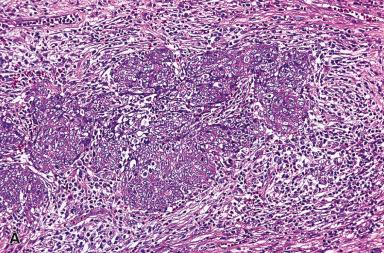
Eccrine poromas occur chiefly on the palms and soles but have been reported in many other sites. They often show a moat and hillock pattern and, histologically, are characterized by a sharp junction between the proliferating, nonpigmented, small keratinocytes and the adjacent epidermis ( Fig. 3.17 ). Within these cords and nests, ducts and sharply outlined squamous islands may be formed. The tumor may be purely intraepidermal, purely intradermal (also referred to as dermal duct tumor ), or (more commonly) involve both areas. Purely intraepidermal poromas have been described in the past as hydroacanthoma simplex . Heavily pigmented and clear cell variants of this tumor have been reported. Ultrastructural, enzymatic, histochemical, and immunohistochemical studies show that the predominant cell of eccrine poroma has features similar to those of the eccrine gland acrosyringium. However, cases have been described with divergent differentiation toward apocrine structures. EMA immunoreactivity is consistently present, and this stain helps in identification of duct lumens. The dermis beneath often shows a distinct proliferation of reactive vessels and some inflammation. The main differential diagnosis of eccrine poroma is with basal cell carcinoma and seborrheic keratosis.
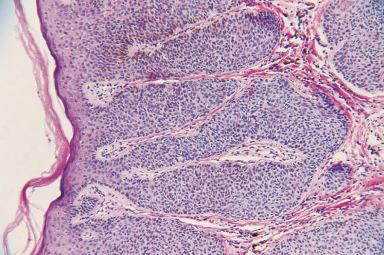
Eccrine poroma should also be distinguished from acrosyringeal adenomatosis (eccrine syringofibroadenoma), a peculiar condition in which papular lesions spread gradually and symmetrically to cover large areas of the body. Microscopically, they are formed by a diffuse proliferation of acrosyringium-related cells in the epidermis and dermis.
The behavior of eccrine poroma is benign, but a malignant counterpart of the tumor, known as eccrine porocarcinoma, exists.
Hidradenoma , also known as eccrine acrospiroma , arises from the distal excretory duct. It forms nodules with occasional cystic foci high in the dermis ( Fig. 3.18 ). Some of the proliferating cells are cytologically similar to those of the poroma. Others have an abundant clear cytoplasm (hence the other synonym, clear cell hidradenoma ), and still others exhibit prominent squamous metaplasia. Immunohistochemically, there is reactivity for keratin, EMA, CEA, S-100 protein, and vimentin, although immunostains are not necessary for the diagnosis. Johnson and Helwig regard eccrine poroma as a subtype of eccrine acrospiroma (hidradenoma), although they are widely considered distinct entities currently. The differential diagnosis of hidradenoma can include glomus tumor because of the presence in both entities of round clear cells and marked vascularity; the distinction between the two entities is easily made by immunohistochemical evaluation.
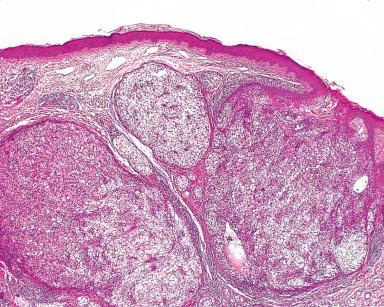
Syringomas are generally multiple, yellowish, papulonodular lesions that occur chiefly on the neck and face (particularly lower eyelids) of women. Other forms are vulvar syringoma, acral syringoma (limited to the dorsal proximal and middle phalanges of the hand), and eruptive syringoma (see later). Microscopically, these tumors are formed by clusters of small ducts lined by epithelium two cells thick, occasionally with comma-shaped extensions ( Fig. 3.19 ). A clear cell variety has been described, resulting from intracellular accumulation of glycogen.
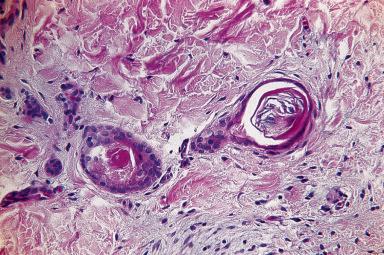
The ultrastructural and histochemical (enzymatic) findings indicate that syringomas are of eccrine rather than apocrine nature. Specifically, the pattern of cytokeratin expression suggests differentiation toward the portion of the sweat duct located in the uppermost portion of the dermis and lower portion of the epidermis (sweat duct ridge).
Eruptive syringoma appears as multiple yellow–brown papules on the neck, anterior trunk, axillae, shoulder, anterior surfaces of the arms, abdomen, and pubic areas of young people ; the process may be reactive rather than neoplastic.
Mixed tumors are benign, nodular, nonulcerated tumors that occur predominantly on the face, head, and neck but also on the extremities and trunk. Histologically, immunohistochemically, and ultrastructurally, their appearance is comparable to that of mixed tumors of salivary gland origin. This includes the presence of cells with an abundant hyaline cytoplasm. Sometimes, eosinophilic globules with radiating fibrillary structures are seen within and around the lumina, their appearance being analogous to that seen in collagenous spherulosis of the breast. Immunohistochemically, the inner layer cells express cytokeratin, CEA, and EMA; the outer cell layers show variable staining for myoepithelial markers, such as vimentin, S-100 protein, actin, calponin, p63, and glial fibrillary acidic protein. Although most of these tumors are thought to be of eccrine type, a variety exhibiting clear-cut evidence of apocrine differentiation has been well documented; this is often admixed with follicular and sebaceous components. Despite the occasionally atypical appearance of the cartilaginous component, the large majority of these tumors are benign.
Tumors having a similar myoepithelial cell component but lacking the epithelial element are known as myoepitheliomas ( Fig. 3.20 ) ; some of these behave in a malignant fashion, apparently with a higher frequency than the homologous salivary gland neoplasms.
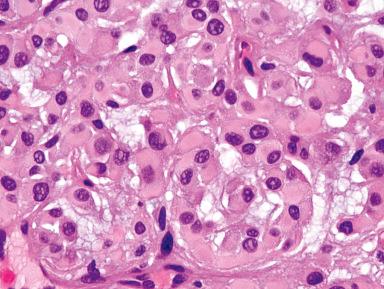
Tumors with an appearance similar to cutaneous chondroid syringomas and myoepitheliomas can also arise in the deep soft tissue.
Classically, cylindroma of the skin has been described as a large, multicentric tumor of the scalp (turban tumor) ( Fig. 3.21 ). In fact, the majority of these slow-growing adenomas are solitary and small, and approximately 10% occur on sites other than the head and neck. Exceptionally, they are seen in association with microscopically identical tumors in the major salivary glands. Microscopically, the heavy accumulation of basement membrane material around and within the tumor lobules is the most important distinguishing feature ( Fig. 3.22 ). The ultrastructural and immunohistochemical features indicate differentiation toward the intradermal coiled duct region of eccrine sweat glands, provide evidence for the participation of myoepithelial cells, and are very similar to those of eccrine spiradenoma. Sometimes, features of cylindroma and eccrine spiradenoma coexist in the same lesion (spiradenocylindromas) . Several examples of eccrine cylindroma undergoing malignant transformation are on record.
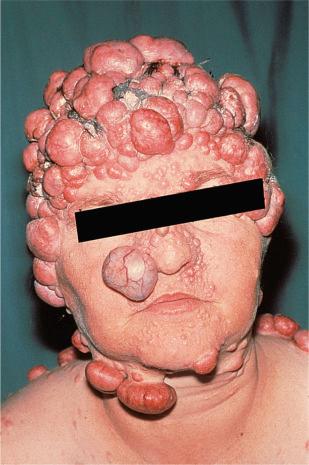
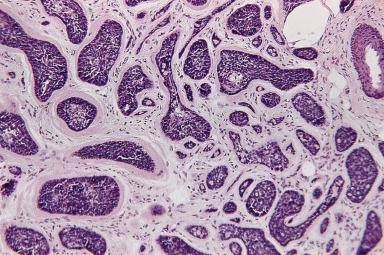
Multiple cylindromas are caused by a mutation in the CYLD gene, found on chromosome 16; both copies of this tumor-suppressor gene must be inactivated for the syndrome to occur.
Spiradenomas are sharply delimited, lobular sweat gland adenomas that can occur almost anywhere in the body and can be extremely painful. They originate from the lower portion of the eccrine duct and are microscopically very cellular ( Fig. 3.23 ). The scanty cytoplasm and marked cellularity may lead the unwary to an erroneous diagnosis of malignancy. We have seen them confused with synovial sarcoma and with metastatic carcinoma. They can also be confused clinically and microscopically with vascular tumors because of their high degree of vascularity ( Fig. 3.24 ). Ultrastructural and immunohistochemical studies have shown that these tumors contain an admixture of epithelial (secretory) and myoepithelial cells.
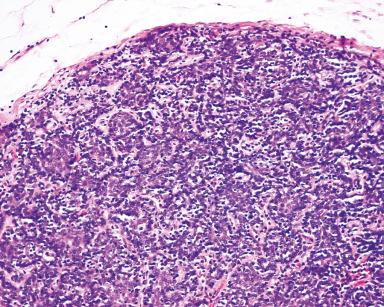
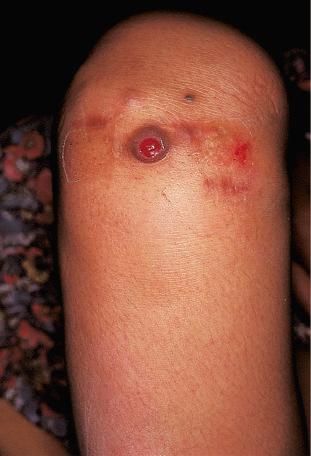
In some spiradenomas, a heavy infiltration by lymphocytes (mainly of T-cell type) is present between the tumor cells; the resulting appearance is reminiscent of a thymoma. The analogy is accentuated by the presence of perivascular spaces containing lymphocytes.
The tumor entity known as cutaneous lymphadenoma (not to be confused with cutaneous lymphoepithelioma-like carcinoma; see earlier) seems to represent a closely related phenomenon. It presents as multiple rounded lobules of basaloid cells with some peripheral palisading, foci of keratinization, and sometimes duct formation, which are admixed with an intense infiltrate of small lymphocytes. The immunohistochemical profile of this tumor has suggested to some authors a histogenetic link with trichoblastoma.
On rare occasions, eccrine spiradenoma shows a focal atypical adenomatous component, the significance of which has not yet been ascertained. In other instances it has been seen to undergo transformation to a high-grade malignancy.
Syringocystadenoma papilliferum is a verrucous, moist tumor that occurs chiefly on the scalp, neck, and face but may be found elsewhere on the skin. It is seen from childhood to senescence, and often there is a history of slow growth or of a recent change in a “birthmark.” Microscopically, a glandular papillary proliferation connected to the skin surface is seen. Dense plasma cell infiltration is common. These plasma cells are predominantly of the IgG and IgA classes. Juxtaposed nevus sebaceus was found in one-third and basal cell carcinoma in one-tenth of the patients reported in the classic article by Helwig and Hackney.
A malignant counterpart of this neoplasm (syringocystadenocarcinoma papilliferum) has been described, as well as a variant containing a prominent fibrous component, known as eccrine syringofibroadenoma and sometimes developing in peristomal skin.
Papillary eccrine adenoma is a distinctive sweat gland tumor, most often located on the distal extremities of black people. Microscopically, tubular structures resembling eccrine ducts are seen; many are dilated and exhibit intraluminal papillomatosis. Local recurrence may supervene, but none of the reported lesions has metastasized. Immunohistochemically and ultrastructurally, the pattern suggests differentiation toward the secretory epithelium of sweat glands. The main differential diagnosis is with low-grade eccrine carcinoma.
Another sweat gland neoplasm with a marked predilection for the digits is digital papillary adenocarcinoma . Formerly subdivided into adenoma and adenocarcinoma based on histologic features, it is now recognized that histologic features are not predictive of behavior and that all are considered carcinomas with metastatic potential. Microscopically, tubuloalveolar and ductal structures alternate with areas of papillary projections protruding into cystic lumina ( Fig. 3.25 ). The appearance is somewhat reminiscent of carcinoma of the breast. Local recurrence is common, and there is risk of metastasis to regional lymph nodes and the lungs.
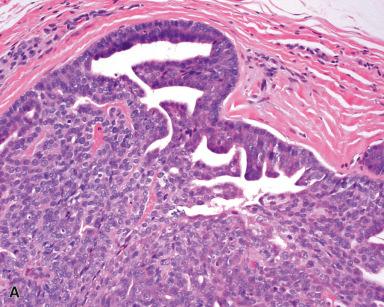
Degos clear cell acanthoma is a morphologically distinct intraepithelial lesion composed of clear, glycogen-filled keratinocytes associated with dermal inflammation. A minor melanocytic population may also be present. Clear cell acanthoma is seen almost invariably in the leg of females, is occasionally multiple, and is thought to arise from intraepidermal eccrine ducts. Similar cytologic changes (“pale cell acanthosis”) can be seen focally in seborrheic keratosis and several other skin disorders as an expression of a reaction pattern of epidermal epithelium. As a matter of fact, clear cell acanthoma itself may be an exaggerated form of this process rather than a true neoplasm.
One could mention here that acanthoma is a generic term that has been used for “benign tumors of epidermal keratinocytes.” It comprises a large number of probably unrelated lesions, such as seborrheic keratosis, verrucous acanthoma, epidermolytic hyperkeratosis, warty dyskeratoma, acantholytic acanthoma, epidermolytic acanthoma, and large cell acanthoma. Consequently, the term “acanthoma” has very little meaning when used without a qualifier.
The lesion traditionally known as intraepithelial epithelioma of Borst–Jadassohn is probably composed of a heterogeneous group of disorders, the two most common being irritated seborrheic keratosis and eccrine poroma (and related intraepidermal sweat gland tumors).
Adenocarcinomas arising from eccrine glands constitute only a minute fraction of sweat gland neoplasms ( Figs. 3.26 and 3.27 ). Most occur in adults, but they have also been reported in children. They can be very difficult to recognize at the microscopic level. Those with well-developed ductal differentiation simulate metastatic carcinoma, particularly from the breast, a similarity highlighted by the fact that they can exhibit immunoreactivity for gross cystic disease fluid protein (GCDF-15) and estrogen receptor protein (although usually not for HER2/neu) The sweat gland carcinomas with large clear cells may resemble metastatic renal cell carcinoma, and those with prominent basaloid formations may be confused with basal cell carcinoma.
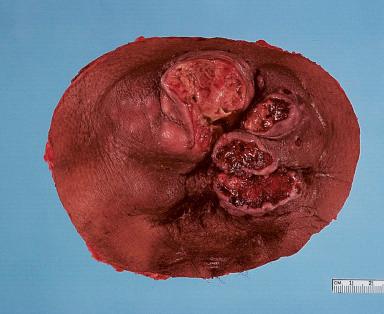
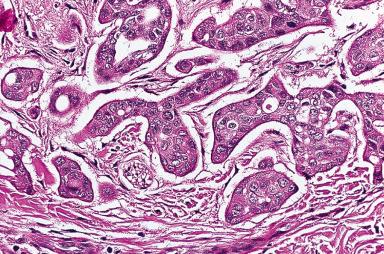
Some sweat gland carcinomas retain morphologic features that allow them to be recognized as the malignant counterparts of the various types of sweat gland adenomas, as already alluded to in some of the previous sections.
Porocarcinoma (malignant eccrine poroma) is the most frequent member of this group. Most cases occur in the lower extremities, like their benign counterparts. Some of the lesions are pedunculated. Microscopically, the architecture is similar to that of eccrine poroma, but there is obvious atypia and high mitotic activity. Epidermotropism is a common feature of this tumor, the resulting picture being that of extramammary Paget disease. Foci of squamous differentiation and clear cell features may be present. Pigmentation may occur and lead to a mistaken diagnosis of malignant melanoma. Metastases occur most frequently in the regional lymph nodes, this often following repeated local recurrences.
Other distinct varieties of sweat gland carcinoma include malignant chondroid syringoma (malignant mixed tumor ) and the closely related myoepithelial carcinoma ( Fig. 3.28 ), malignant dermal cylindroma, malignant syringoma (syringoid eccrine carcinoma), hidradenocarcinoma (malignant acrospiroma), digital papillary adenocarcinoma (see Fig. 3.25B ), and apocrine carcinoma.
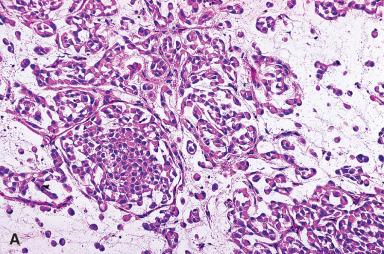
In addition to these presumably de novo lesions, eccrine acrospiroma, spiradenoma, syringoma, and cylindroma can undergo malignant transformation, the phenomenon manifesting clinically as enlargement of a cutaneous nodule of long standing. This transformation is usually in the form of a high-grade carcinoma, including the variant known as sarcomatoid carcinoma or carcinosarcoma.
Several other distinctive types of sweat gland carcinoma occur. One is primary mucinous carcinoma , often appearing in the scalp and the head and neck of elderly patients, especially involving the eyelids. Its microscopic appearance resembles mucinous carcinoma of the breast by virtue of the presence of clusters of tumor cells floating in lakes of mucin. The similarity is reinforced by the fact that, on occasion, the mucinous pattern is associated with an infiltrating ductal pattern. Both pure and mixed forms exist. It appears likely to be related to endocrine mucin-producing sweat gland carcinoma , which shares clinical, morphologic, and immunophenotypic features. The immunohistochemical profile of mucinous carcinoma suggests differentiation toward the eccrine secretory coil, but some cases have been thought to exhibit apocrine-type features. They may also contain a myoepithelial cell component, a useful feature in the differential diagnosis with metastatic carcinoma.
This tumor should be distinguished from the even rarer primary adenoid cystic carcinoma and mucoepidermoid carcinoma of the skin, two tumors morphologically and immunohistochemically equivalent to the salivary gland neoplasms that bear those names. More important, it should be distinguished from mucinous syringometaplasia , a non-neoplastic reactive change that can be accompanied by prominent epithelial hyperplasia.
Another variant of sweat gland carcinoma, microcystic adnexal carcinoma , also termed sclerosing sweat duct carcinoma , appears as a slow-growing, indurated nodule or plaque, usually on the face. The upper lip is a particularly common location. Microscopically and immunohistochemically, the tumor shares several features with benign syringoma and desmoplastic trichoepithelioma, and it may be impossible to distinguish on superficial biopsies. Cords and nests of uniform keratinocytes, keratin-containing cysts, and foci of ductal differentiation are present ( Figs. 3.29 and 3.30 ). Exceptionally, there is sebaceous differentiation. The stroma has a dense, collagenous quality. There is often CK15 positivity, a potentially useful feature in the differential diagnosis with basal and squamous cell carcinoma. The tumor has invasive properties, sometimes extending into the subcutaneous fat, perineurial spaces, and/or mandibular bone. Recurrence is common, but metastases are extremely rare.
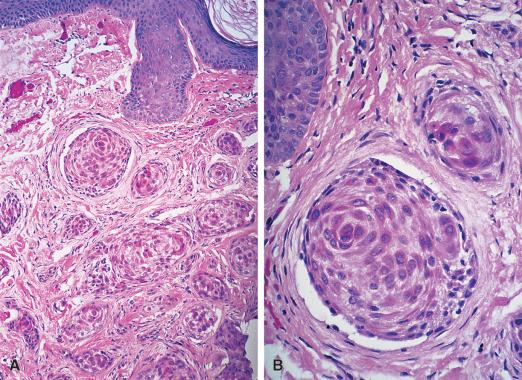
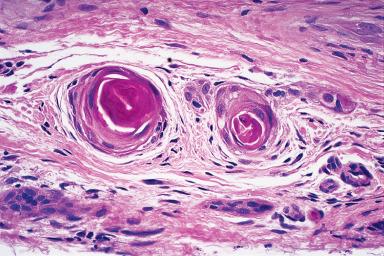
Nearly all types of sweat gland carcinoma exhibit immunoreactivity for cytokeratin, CEA, and EMA, like their benign counterparts.
Extramammary Paget disease results from the presence in the epidermis of carcinoma cells with signs of glandular differentiation. Concomitant involvement of eccrine glands and/or hair follicles is nearly always present, whereas dermal invasion is seen in a minority of cases, the frequency varying according to the location (extremely rare in the vulva and more common in the perianal region). Cases limited to the epidermis are explained by postulating an origin from the intraepidermal portion of the sweat glands or from primitive basal cells with the capacity to differentiate toward glandular elements.
The labia majora, scrotum, and perineum are the most frequent sites, with adjacent areas following. The lesions are grossly circinate, annular, erythematous, and eczematoid plaques. Histologically, large, pale, vacuolated cells are seen concentrated just above the basal layer ( Fig. 3.31 ). They may be single or arranged in rows, small nests, or glandular formations. A cleft-like separation is often seen between the Paget cells and the adjacent non-neoplastic keratinocytes. Electron microscopic examination shows that Paget cells are not altered keratinocytes or melanocytes but rather cells with glandular differentiation. In contrast to Paget disease of the breast, the extramammary form is consistently positive for mucin stains. Immunohistochemically, the tumor cells show reactivity for EMA, CEA, CK7, and CK19 (regarded as a marker or follicular stem cells) and the types of low-molecular-weight cytokeratin present in simple epithelia ( Fig. 3.31 ).
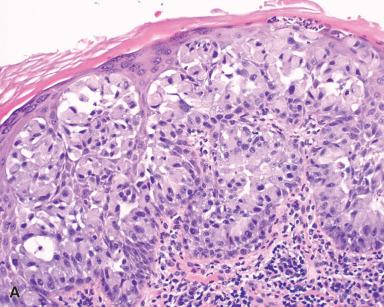
The theme common to all forms of Paget disease is the origin of the tumor from epithelial cells with the capacity to differentiate toward the glandular structures of the region. These are the mammary glands in the breast, the apocrine glands in the vulva, and the perianal and/or rectal glands in the perianal region. This probably explains the fact that there is heterogeneity in the immunohistochemical profile of Paget disease depending on the site of occurrence but in concordance with that of the corresponding normal glands and adenocarcinomas of the region. Thus, vulvar Paget disease is positive for GCDFP-15 and hormone receptors (curiously, androgen rather than estrogen or progesterone) and shows a pattern of lectin-binding sites similar to that of apocrine glands. Conversely, perianal Paget disease often shows positivity for cytokeratin 20, a feature of colorectal glands. Patients with perianal Paget disease that is positive for cytokeratin 20 usually have an underlying rectal adenocarcinoma with secondary involvement of the skin.
Complete surgical excision is the treatment of choice, but this may be difficult to achieve because of the ill-defined gross edges of the lesion.
The differential diagnosis of extramammary Paget disease includes pagetoid Bowen disease, pagetoid actinic keratosis, benign and malignant melanocytic lesions, metastatic epidermotropic carcinomas from breast and other sites, and so-called clear cell papulosis. Most of the reported cases of the latter condition have been in children younger than 4 years and have been characterized by multiple small whitish maculopapular lesions that, microscopically, are seen to contain pale cells with a similar immunohistochemical profile to that of Paget cells ( Fig. 3.32 ). These cells are probably related to the so-called Toker cells as seen in the nipple.
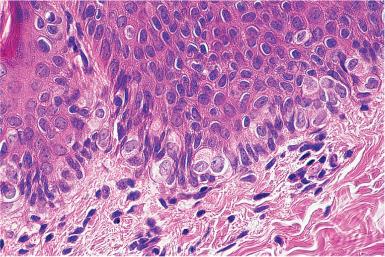
It is possible that some of the sweat gland tumors already described, particularly syringocystadenoma papilliferum, cylindroma, and mixed tumor, exhibit apocrine differentiation. As a matter of fact, the existence of eccrine and apocrine forms of the latter has been proposed. Furthermore, stains for the apocrine marker GCDFP-15 are often positive in sweat gland neoplasms. However, tumors composed exclusively of apocrine glands are extremely rare.
Apocrine cystadenoma is discussed in a different section.
Tubular apocrine adenoma is characterized by dermal and subcutaneous tubular structures of apocrine type arranged in a lobular fashion. The lesion is very similar to syringocystadenoma papilliferum.
Papillary hidradenoma and ceruminous adenoma have been traditionally regarded as tumors of apocrine glands.
Become a Clinical Tree membership for Full access and enjoy Unlimited articles
If you are a member. Log in here